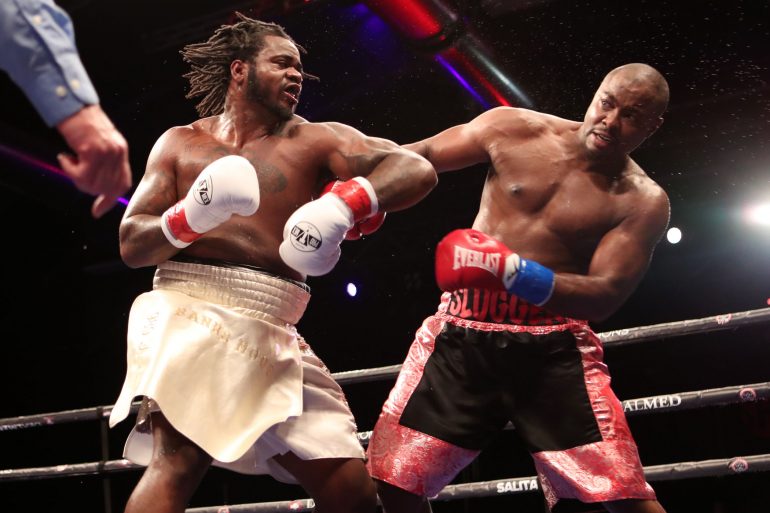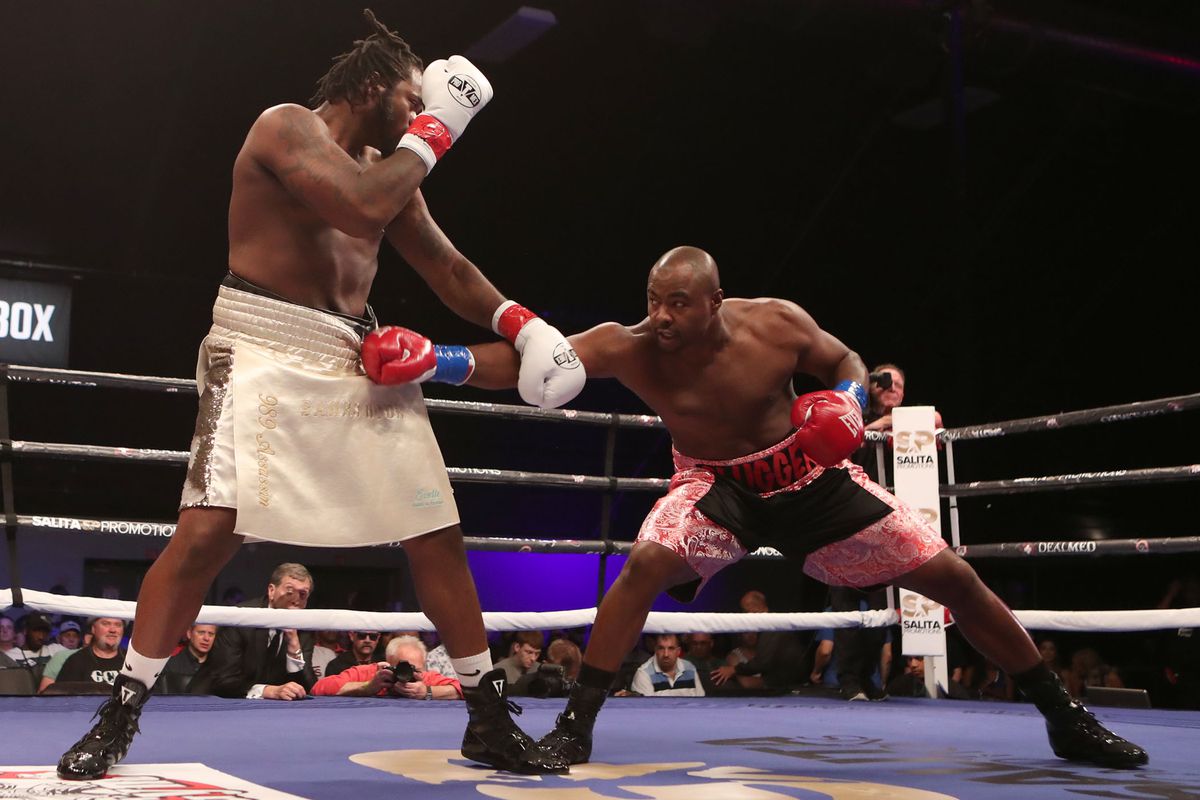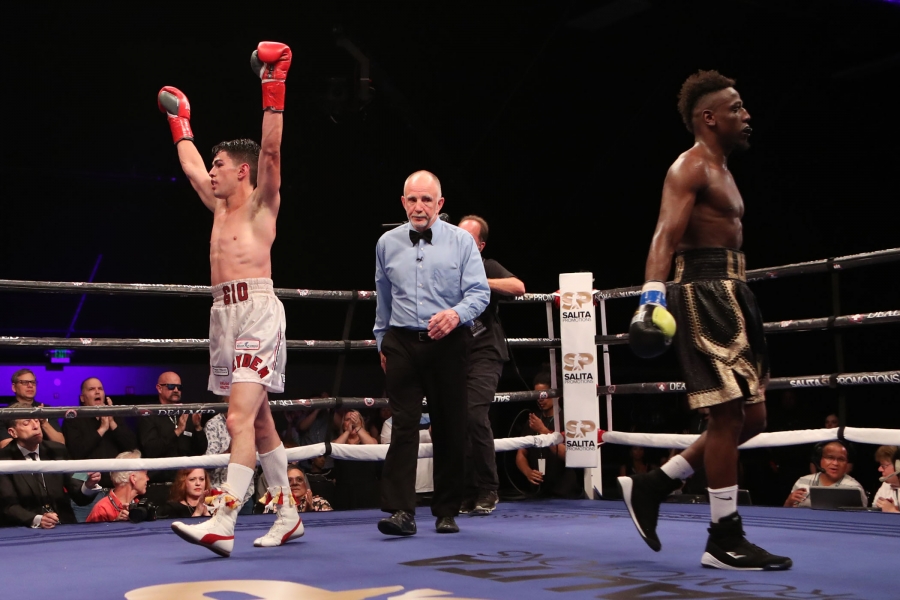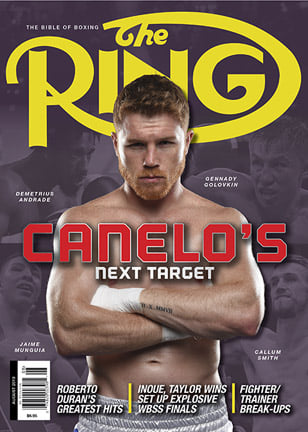The Travelin’ Man goes to Tacoma: Part Two

Please click here to read Part One.
Friday, July 12 (continued): Hall of Fame trainer George Benton said his chief second used to tell him, “Win this one; look good in the next one.” That was the sentiment following heavyweight Jermaine Franklin Jr.’s lopsided but less-than-scintillating victory over Rydell Booker on the Claressa Shields-Christina Hammer undercard April 13 in Atlantic City, a sentiment that the fighter also shared.
“I think I had a decent performance,” Franklin Jr. told The Ring magazine’s Joe Santoliquito back then. “There’s some stuff I could work on. I overcrowded myself a little bit. I was a little overanxious. (Booker) had a lot more experience than me and used it to his advantage. He could see what I was doing. I learned to stay more patient because I had him hurt a few times but once I got overanxious, my whole game plan went out the window. I started messing up and making crazy mistakes I shouldn’t have. Now it’s back to the drawing board to work on my mistakes and come out bigger and badder next time. I’d like to be in a bigger fight against a top guy next but we know how the boxing business works, so I’ll just keep working and wait for my turn.”
Almost three months to the day later, the 25-year-old prospect faced southpaw Jerry Forrest, a 31-year-old with a 25-2 (with 19 knockouts) record whose two losses came in his two previous “step-up” fights against Gerald Washington (KO by 2) and Michael Hunter (L UD 8) in back-to-back outings in August 2013 and June 2014 respectively. Not a “top guy” like Franklin wanted but an appropriate step up from a 38-year-old Booker who was appearing in his fourth fight since ending a 13 ½-year retirement. This was the “next time” Franklin spoke about in April and this was the fight in which he needed to back up the words of promoter Dmitry Salita, who called him “America’s best heavyweight (prospect)” in a story posted by the Detroit Free Press earlier in the week.
However instead of progressing, Franklin appeared to regress – so much so that the split decision in his favor was booed by the crowd inside the Emerald Queen Casino, criticized by the “ShoBox” broadcast team and produced descriptions of his victory in the press as an “escape” or “fortunate.” The record will state that Alan Krebs and Tim Wood judged Franklin a 97-93 winner but the conventional wisdom was more with Hunter Walton’s vote for Forrest, if not exactly his 96-95 score.
The CompuBox numbers offer nuggets for both sides of the equation, although more of them sided with the man who walked out of the ring with his third “L” than with the fighter who raised his record to 19-0 (13). The 240 ¼-pound Franklin – who was five pounds lighter than was the case against Booker so he wasn’t bigger than he was in April – was the busier fighter as he averaged 46.6 punches per round to Forrest’s 38.2, was the more prolific power hitter as he led 94-76 in connects, was the slightly more accurate fighter with his hooks, crosses and uppercuts (36.2% to Forrest’s 35.2%) and dominated in terms of body punching (40-5).

Heavyweight Jermaine Franklin (left) vs. Jerry Forrest. Photo by Dave Mandel/SHOWTIME
However the more compelling numerical arguments can be made for Forrest, who, at 222 ¾, was 6 ¼-pounds trimmer than his most recent fight, an eight-round unanimous decision win over Joshua Tufte in Lynchburg, Virginia, on the same night Franklin defeated Booker in Atlantic City. Despite being the less active fighter, Forrest still led 121-107 in total connects. Forrest landed the jab much more successfully in terms of raw numbers (45-13) and in percentage (27%-6%). Perhaps most importantly Forrest led 7-2-1 in the CompuBox round-by-round breakdown of total connects – relevant because clean punching is such a key judging factor.
In April, Franklin justified his victory by finishing stronger than Booker in rounds six through 10 (71-40 overall and 57-30 power, including 27-14 overall and 21-7 power in the final two rounds). However against Forrest, Franklin was swept in rounds six through 10 (66-49 overall, including 27-2 in landed jabs) and the 10th proved to be Forrest’s strongest of the fight in terms of connect margin as he led 17-11, larger than the gaps he earned in the other six rounds in which he led (one connect in the first, two connects in the ninth, three connects in the third and eighth and five connects in the sixth). This negative second-half fight-to-fight contrast is why this performance represents a step backward for Franklin. While he wanted to be “badder” next time, he certainly didn’t mean it to be this way.
Conversely Forrest might have officially lost the fight but the trajectory of his career turned upward with this showing. He was perceived to be the winner in many quarters and he’ll likely get another opportunity on TV to ascertain whether his outing against Franklin was a genuine, long-term measure of his talent or whether it was just an inspired night at the office. My gut tells me that Forrest could get a second shot on ShoBox but given his underwhelming performances against Booker and Forrest, will Franklin Jr. get a third?
*
Local hero Giovanni Cabrera Mioletti needed the first four rounds to adjust to Luis Porozo’s free-swinging, highly mobile fighting style. His punches often whizzed past the Ecuadorian’s head or were blocked by his arms and elbows while Porozo’s fists pushed the pace (54 punches per round to Cabrera Mioletti’s 41 in rounds one through four) and connected more consistently (46-34 overall, 44-25 power in that same span). The 29-year-old looked faster, more composed and more fluid than his 24-year-old rival and an upset appeared possible.
Then came the fifth round and with it, the shift that turned the fight Mioletti’s way. The vehicle by which the Washingtonian seized control was his jab, which registered just nine connects in 67 attempts in rounds one through four (13%) but eight connects in 30 attempts in round five (27%). His success in establishing range with his southpaw jab led to an extraordinary leap in terms of his power punching as he landed 14 of 23 – or 61% – of his hooks, crosses and uppercuts, a far cry from the 25 of 97 (26%) he logged in rounds one through four. Meanwhile Porozo declined from 13 of 53 overall and 12 of 43 power in round four to just 6 of 47 overall and 5 of 37 power in round five.

Junior lightweight Giovanni Mioletti (left) vs. Luis Porozo. Photo by Dave Mandel/SHOWTIME
Rounds six through 10 saw Mioletti steadily pull away as he out-landed Porozo 92-41 overall, 38-0 jabs and 54-41 power, average a robust 63.6 punches per round to Porozo’s 50.8 and sweep his way to a comprehensive unanimous decision victory (98-92 by Krebs and Wood, 97-93 by Walton). The CompuBox round-by-round breakdown had Mioletti ahead 7-3, with the American sweeping the final six rounds.
Were Mioletti’s early issues the result of nerves – this was his national TV debut – the anxiety of fighting such an important match before his home fans or the difficulties in solving Porozo’s waterbug style? My guess is it was a mixture of all three but once Mioletti’s mind settled into the fight, the rest of his body followed and the result was exactly what he and his team had envisioned. It was a growing-up fight for Mioletti, who, at 5-feet-8 ½ inches, is pretty tall for a junior lightweight.
The victory advanced Mioletti’s record to 17-0 (with 7 KOs) while eroding Porozo’s to 14-1 (with 7 KOs). Given his relative lack of power in comparison to his peers, his future fights may well be tests of conditioning and concentration against sluggers and indicators of poise and patience against boxers like Porozo. We now know he has the latter traits and it will be interesting to see if he has the first set of assets going forward.
*
Normally Dennis and I would leave ringside immediately after sign-off but here I needed to wait a bit because I lent my backup computer’s AC adapter to a member of Showtime’s PR team whose laptop battery was running low. We spent the extra time watching the first four rounds of the walk-out bout – Eric Hunter versus the 121-fight veteran German Meraz, a fight in which the usually iron-chinned Meraz was floored at the end of round three by a pinpoint hook. The fight was stopped by the ringside physician in round five shortly after an accidental butt opened a cut over Meraz’s left eye.
Once I retrieved my plug, Dennis and I indulged in some post-fight pizza, after which he drove me back to the La Quinta. Because taxis are not readily available, I arranged for the front desk to have a cab arrive at 7:15 a.m., the agreed-upon time by me and my carpool partner, audio man Todd Torrance. After inputting the night’s numbers into the database and sending the files to the Draft Kings people, I turned out the light shortly before midnight.
Saturday, July 13: I stirred awake at 5 a.m. (8 a.m. body clock time) and when I arrived in the lobby to check out of my room at 7:10, the taxi – and Todd – were waiting for me. I probably shouldn’t have been surprised by Todd’s punctuality; he once served as an infantryman in Iraq.
Because traffic was light, we arrived at the airport a little more than 30 minutes after we left the hotel. Once inside the American Airlines terminal, it didn’t take me long to find another person to chat with, for moments after clearing security, matchmaker John Beninati called out my name and we spent the next hour chatting for what I thought was our shared flight to Dallas-Fort Worth out of Gate D 9. However a check of the boarding pass revealed I was to leave an hour later, albeit from the identical gate.
I spent the extra 60 minutes eating a light breakfast with an older couple from Albuquerque, New Mexico, who was returning from a cruise and an Alaskan postmaster with a love of fishing and moose hunting. I didn’t get any work done but I still considered it time well spent.
The next four hours were split between resting my eyes and re-reading Jimmy Connors’ autobiography “The Outsider,” which I originally purchased six years ago. The passage of time served to make the words I first read in 2013 fresh again. I landed in Dallas at 4:30 p.m. CDT but our scheduled 6:38 p.m. flight to Pittsburgh departed 10 minutes late (at least officially – the delay seemed far longer) because the new flight crew’s plane landed two concourses away and later than expected. Such are the vagaries of modern aviation.
The plane landed in Pittsburgh at 10:25 p.m. EDT – only five minutes later than advertised – and the rest on both flights did me a world of good as I had no problem completing the two-and-a-half-hour drive home. I called home and predicted I would arrive “between 1:15 and 1:30 a.m.” My actual arrival time: 1:22 a.m.
The late hour demanded that I’ll have to wait to watch all the boxing I missed – the shows on ESPN, DAZN and FS1 as well as Argentina’s TyC channel. Because I’m now in pretty good shape on the research, I’ll have some time to catch up before starting my next trip, which will see me travel to Baltimore to chronicle a “Showtime Championship Boxing” tripleheader consisting of a lightweight match between Ladarius Miler and Jezreel Corrales, a junior lightweight contest between former champs Yuriorkis Gamboa and Roman Martinez and, in the main event, WBA junior lightweight titleholder Gervonta Davis vs. Ricardo Nunez.
Until then, happy trails!
*
Lee Groves is a boxing writer and historian based in Friendly, West Virginia. He is a full member of the BWAA, from which he has won 16 writing awards, including two first-place awards, since 2011. He has been an elector for the International Boxing Hall of Fame since 2001 and is also a writer, researcher and punch-counter for CompuBox, Inc. He is the author of “Tales from the Vault: A Celebration of 100 Boxing Closet Classics” (available on Amazon) and the co-author of the newly released book “Muhammad Ali: By the Numbers” (also available on Amazon). To contact Groves about a personalized autographed copy, use the email [email protected] or send him a message via Facebook.
Struggling to locate a copy of The Ring Magazine? Try here or
Subscribe
You can order the current issue, which is on newsstands, or back issues from our subscribe page.
















